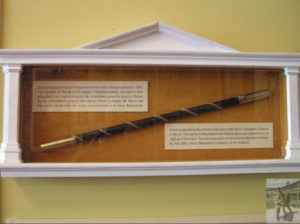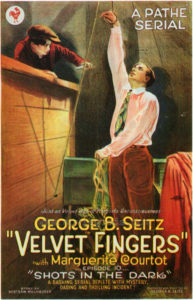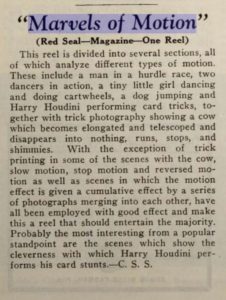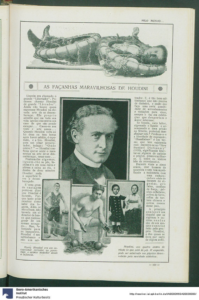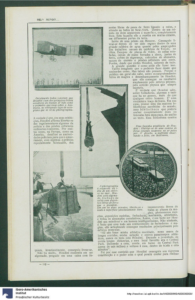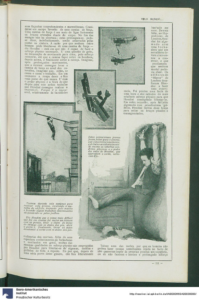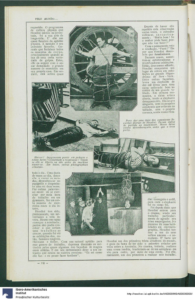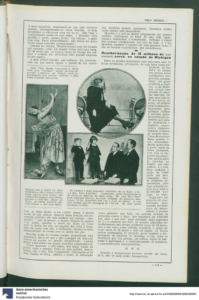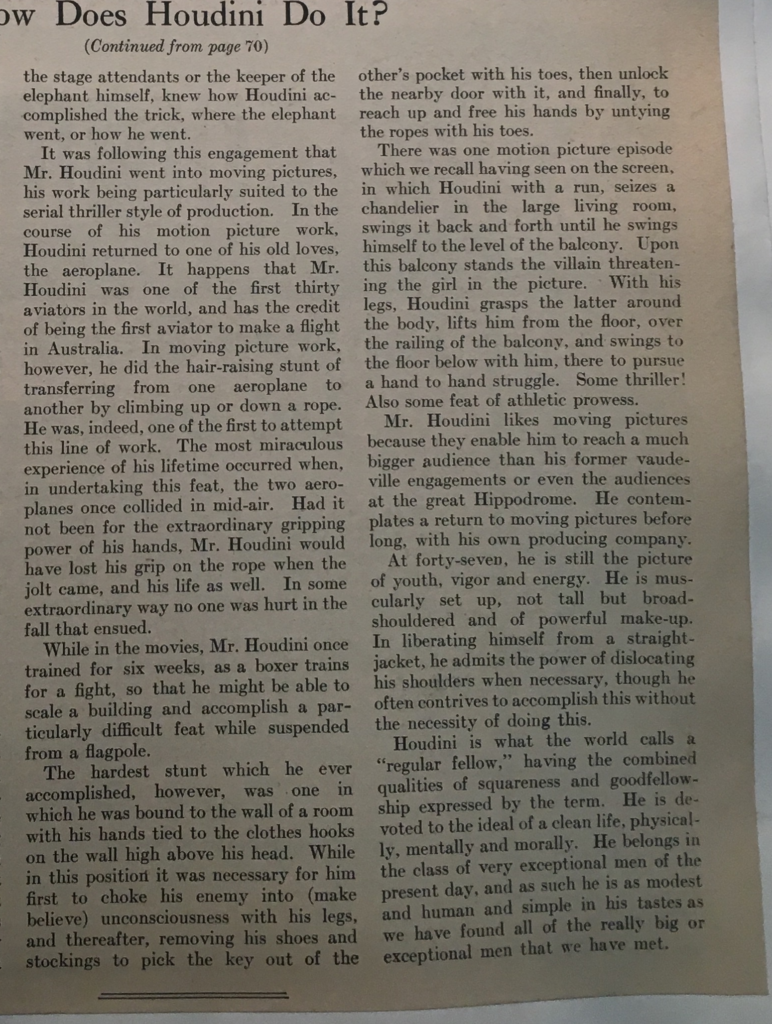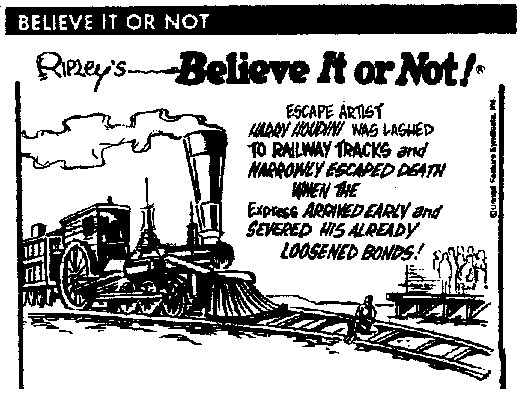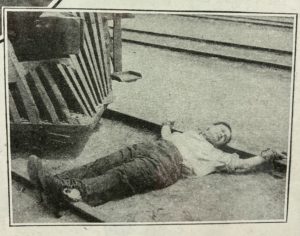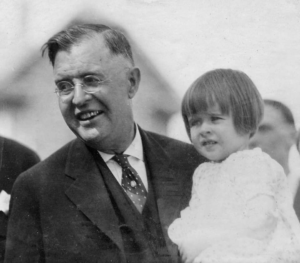
W.W. Durbin with Jim’s Mom in 1926
Earlier this year, I sent the following email to the great grandson of W. W. Durbin:
Hi Jim!
I have been studying Houdini for 45 years and have a Houdini blog, HarryHoudiniCircumstantialEvidence.com that I have been running since 2011.
Leo Hevia, a Houdini Colleague, has been in contact with you regarding the search for a Houdini handcuff associated with the famous Mirror Challenge that was given to your great grandfather, W.W. Durbin, by Bess Houdini.
According to the February 1934 Linking Ring article, “With the Old Masters” by William W Durbin, President I.B.M., Kenton Ohio:
Today, I have in my possession, presented to me by Mrs. Houdini, the handcuffs which were made by Birmingham blacksmith and who took five years in making same, which Houdini got out of in the London Hippodrome after he worked for almost seventy minutes to release himself…I have never been able to find any magician or other person who can open and close these handcuffs.
Attached is a photograph from a May 18, 1933 Pittsburg Sun Telegraph newspaper of the handcuff.
Last year, I shared three ground-breaking blog posts on my latest investigation and findings on the Mirror Challenge. Which Included additional information, insight and new photographic evidence on the Mirror Challenge confirming Houdini escaped from a cuff known as the “Tatler Cuff” as opposed to the Mirror Cuff in David Copperfield’s collection:
Any information you can provide to help determine what happened to these cuffs would be greatly appreciated. Did they stay with the Durbin family? Or did the I.B.M get them, or did they become part of Egyptian Hall Museum Collection, which has had a number of different owners (David Price, David Price III, Mike Caveney and George Daily) or did something else happen to them.
Thank You for your time,
Joe Notaro

May 18, 1933 Pittsburg Sun Telegraph
The following is the reply I got back from Jim:
Hi Joe. I did do some investigating. Happy to discuss more on the phone, but here is what I did:
-
- I checked my David Price file, as I had a number of long letters from him.
- You know that David was the buyer of the Durbin memorabilia left over from the American Egyptian Hall. I visited him and saw the museum he built in his own home in Nashville.
- Before David, the remnants of the magic theater were acquired by two brothers, Tom and Bob Dowd—Kenton farmers. Tom became a judge, I believe. Before he died he brought me Durbin memorabilia, including a scrapbook from his time as Register of the Treasury.
- But in my Price file is an article written by Bob Dowd about how they acquired the collection from the August 1994 Linking Ring. Here is the line of most importance to you. “His apparatus, books and whatever paraphernalia existed was sold, perhaps to Abbotts for resale.”
- So my guess is the handcuffs were sold by my great-grandmother, probably not checking. But best guess is they went through Abbotts.
- One fun sidebar. Two years ago, some nice guys from Kenton, Ohio, asked me to come over and speak about Durbin and my book on him. They took me to the home that was made from the magic hall. The Dowds moved it to the country and made a one-story home of it. Completely cool to see that the wallpaper on the ceiling was still intact in what is now an attic. I have photos. The previous owner said she definitely heard an orchestra playing sometimes and felt the presence of a good spirit at times. Who knows, but the report seemed sincere. Maybe those cuffs are hidden in the walls of that home? We need to get Geraldo Rivera on it!
Will keep thinking about it. I cannot tell you how hard it is for me to know these artifacts from my family are far-flung—but most people take good care of their collections, like Mike Caveney.
I am pleased you reached out, Joe. Nothing like a good old-fashioned obsession with a great riddle!
Jim
Below is a snippet from the August 1994 Linking Ring article, Egyptian Hall, the Reprise, by Bob Dowd:
When Durbin’s estate was settled, I was living on my own in Cincinnati. His apparatus, books and whatever paraphernalia existed was sold. I don’t know to whom, perhaps to Abbotts for resale. But I’m not sure of that.
At any rate, the building, with its vestibule, walls and ceiling covered with a plethora of photos mounted under glass, as well as the large, book-like folio of 8×10’s which stood, head-high, to the right of the stage remained.
The distinctive front curtain with its Egyptian painting was left in place. The hangings also remained on the rather deep stage, with its side curtains and traveler to divide the stage into two sets. Backstage, the sides and rear were lined with seven-foot high glass-fronted, shelved cabinets which had provided large storage. And, of course, there were the footlights with a carpeted walk at the center leading to steps down to the auditorium floor.
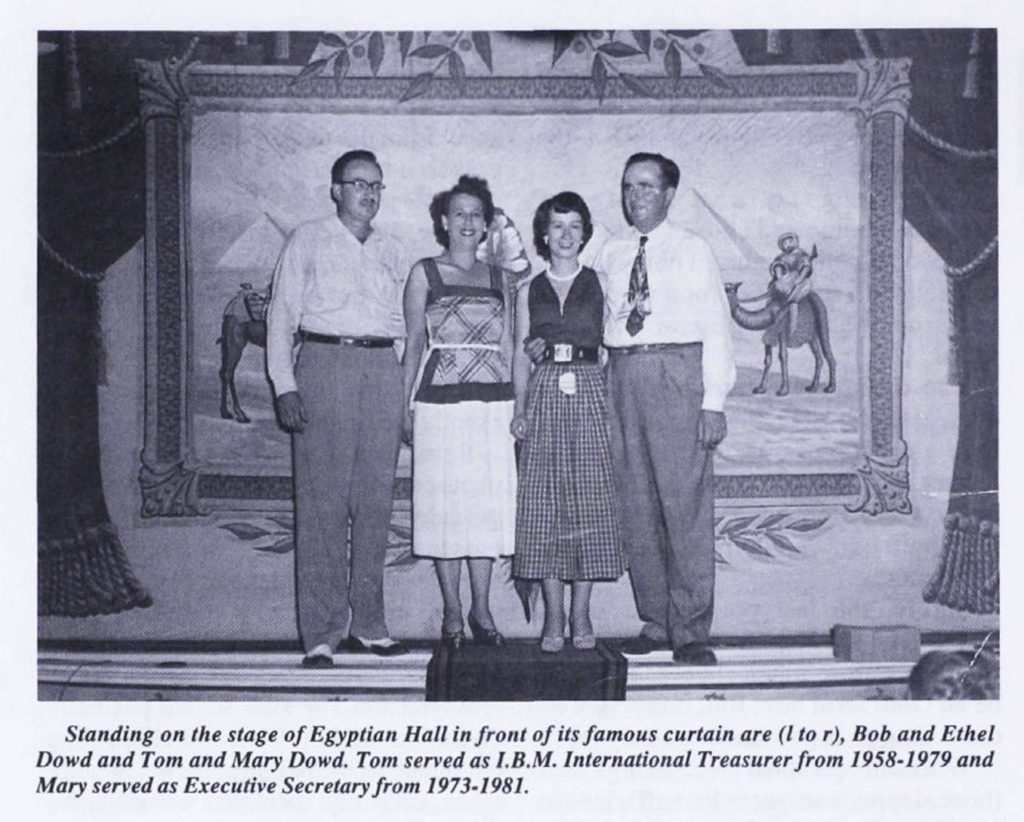
Photo from The Linking Ring Aug 1994
So, we learned from Jim and the August 1994 Linking Ring article that there were additional owners (Tom and Bob Dowd) of the Egyptian Hall Museum prior to David Price. We also learned that most likely the handcuffs and other paraphernalia along with Durbin’s apparatus and books were sold (possibly to Abbott’s) by his great grandmother after Durbin’s death (Feb 4,1937) and before Tom and Bob Dowd acquired the remnants of the magic theater (1940).
So where do we look now, Abbotts? Or maybe those cuffs are hidden in the walls of that home made from Egyptian Hall?
My sincere thanks to Jim Robenalt (great grandson of W.W. Durbin) for adding a new piece to the puzzle and to Leo Hevia for laying the groundwork for me to contact Jim.
BONUS:
The Tatler Cuff is not the only thing missing from Durbin’s collection. There are three magic wands made of the flooring from the original independence Hall in Philly, one given to Durbin which is missing.
Update:
Thanks to Jim Klodzen, we now know that one wand was given to Harry Blackstone Sr and is is housed at the American Museum of Magic. See photo below.
